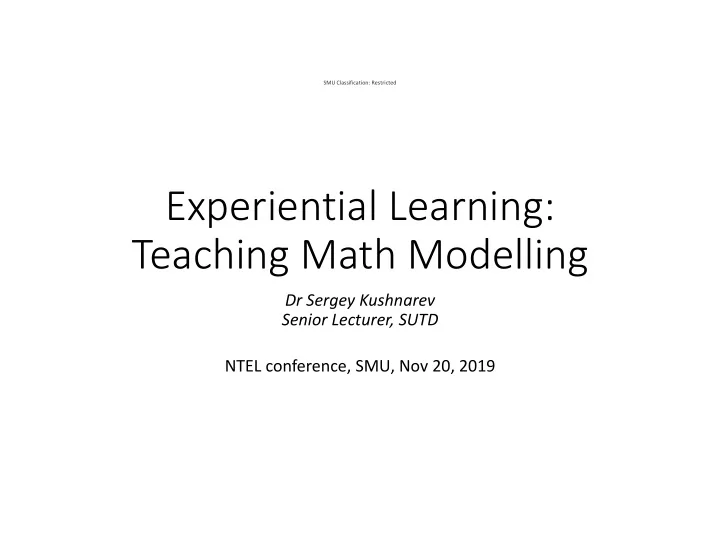

SMU Classification: Restricted Experiential Learning: Teaching Math Modelling Dr Sergey Kushnarev Senior Lecturer, SUTD NTEL conference, SMU, Nov 20, 2019
SMU Classification: Restricted Outline • Experiential Learning • Math Modelling • What is it. • How is it taught. • Math Modelling as Experiential Learning • Challenges/Issues.
SMU Classification: Restricted What is Experiential Learning? Kolb Learning Cycle: • Student's personal involvement through concrete experience ; • Student reflects on this experience, looking for meaning • Student applies this meaning to form a logical conclusion; • Student experiments with similar problems, which results in new concrete experiences Then the learning cycle begins again (Hartman, 1995, Kolb, 1984)
SMU Classification: Restricted Svinicki, Dixon, 1987
SMU Classification: Restricted
SMU Classification: Restricted Motivation • Engages students in the mathematics • Enhances metacognition • Improves students’ retention of content • Prepares our students for careers: • Ability to work with open‐ended scenarios • Teamwork skills • Communication skills
SMU Classification: Restricted What is mathematical modeling? • Is a process that uses math to represent, analyze, make predictions, or provide insight into real‐world phenomena. • A mathematical model is a representation of a system/scenario that is used to gain qualitative and/or quantitative understanding of a real‐ world problem and to predict future behavior.
SMU Classification: Restricted Math Problem vs Modeling Problem • 1. The population of Singapore is 5.5 million, and 35% of its citizens recycle their plastic water bottles. If each person uses 9 water bottles per week, how many bottles are recycled each week in Singapore? • 2. How much plastic is recycled in Singapore? • we usually do not have complete information when trying to solve real‐world problems!
SMU Classification: Restricted A Solution VS The Solution • People solving modeling problem may have different approaches and will come up with different, valid alternative solutions. • Pitch to students: • Mathematical modeling questions allow you to research real‐world problems, using your discoveries to create new knowledge. • Your creativity and how you think about the problem are both valuable in finding a solution. This is part of what makes modeling so interesting!
SMU Classification: Restricted Modeling Steps 1. Defining the Problem Statement 2. Making Assumptions/ Defining Variables 3. Getting a Solution 4. Analysis and Model Assessment 5. Reporting the Results
SMU Classification: Restricted
SMU Classification: Restricted Logistics • Math modeling was taught to 1 st year engineering students in Term 2 Advanced Math class • Whole cohort (400‐500 students) is divided into 8‐10 classes of ~50 students each. • 5 steps of Math Modeling were introduced in the first 5 classes of the term (30mins). • Students were split into groups (3‐5pax) and brainstormed on the whiteboards. • They submit their work via piazza.com on the same day and receive online feedback from faculty. • Each step was graded by participation (1% per step, 5% total)
SMU Classification: Restricted
SMU Classification: Restricted
SMU Classification: Restricted
SMU Classification: Restricted Brainstorming for “Defining the Problem Statement”
SMU Classification: Restricted Project (Weeks 3‐6): less guidance, more freedom In the Week 3 students were assigned a Math Modelling project (due in Week 6): • 2018: “ define the notion of a well‐airconditioned room . Determined whether the room in the data provided is well‐airconditioned or not” • 2019: “Civil Aviation Authority of Singapore (CAAS) has recently established Aviation Studies Institute (ASI) at SUTD. In light of this article, ASI tasked SUTD students to model the impact of airplane noise on Singaporeans .”
SMU Classification: Restricted Final project (Weeks 8‐13): even more freedom, even less guidance. • In Term 2 students are engaged in “Introduction to Design” class. • They build a prototype of an object which solves a certain need/issue (each year there is a theme) • Students need to come up with their own math modelling question and solution to address the issue at hand. • Deliverable: a Technical Report and an Executive Summary of their work
SMU Classification: Restricted Math modelling is a perfect example of Experiental Learning!
SMU Classification: Restricted Svinicki, Dixon, 1987
SMU Classification: Restricted Challenges in Teaching Math Modeling • Open‐ended approach: There is no “right” answer. • Instructor creativity and ability to think on their feet is needed. • Often instructors need to be taught Math Modelling AND How to teach Math Modelling. • Consistent grading across different instructors is a challenge.
SMU Classification: Restricted Thank you • Any questions?
Recommend
More recommend